June 16, 2025 | 00:49 GMT +7
June 16, 2025 | 00:49 GMT +7
Hotline: 0913.378.918
June 16, 2025 | 00:49 GMT +7
Hotline: 0913.378.918
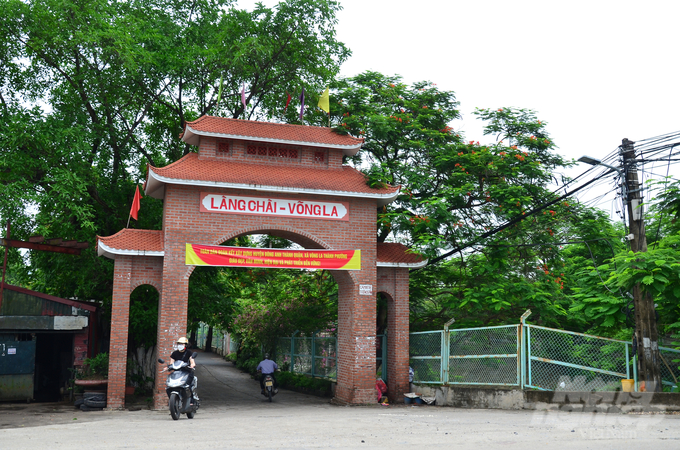
Recognized as a traditional craft village in 2019, Vong La is where many households produce tofu. Photo: Duong Dinh Tuong.
Vong La (Dong Anh district, Hanoi) was a fishing village located along the banks of the Red River. Next to the burning red stove, the old people still tell their children and grandchildren this story: In the era of Hung King, there was a time when three saints came to help Tan Vien fight the flood. They saw the charming scenery of this, so they stopped here for a while and later taught the art of tofu making to villagers.
Vong La people learn the trade from a young age by watching their parents do it, then helping them with soaking beans, grinding beans and finally, directly doing the difficult steps. The tofu block of this fishing village has this flexible texture, full of flavor because it is produced from shiny yellow soybeans, milled by stone mortar and squeezed manually.
There was a time making tofu became the village’s main occupation, and the whole village left the fishing work behind. When the North Thang Long industrial park was opened, the village's farmland was no more. Alluvial grounds along the Red River used to grow soybeans have been abandoned for 15 years, but Vong La still retains its craft thanks to buying beans from other places, and now imported beans.
Mr. Nguyen Quang Hieu, head of Vong La village said, “10 years ago, 70-80% of households made tofu when Vong La was recognized as a craft village in 2019, there were more than 50 households, now we only have roughly 20 households, along with Green Sprout Company and the Vong La Youth cooperative”.
According to Mr. Hieu, 1 kg of soybeans costs VND 18,000 - 20,000, produces 3 kg of tofu, sells for VND 30,000-36,000, not including the cost of electricity, water and labor. Working on 20-25 kg of soybeans a day, Hieu and his wife make a profit of approximately VND 150,000-200,000. As a result, most of the young people have given up on the job, so now the youngest tofu maker is over 40 years old, the rest are middle-aged and elderly.
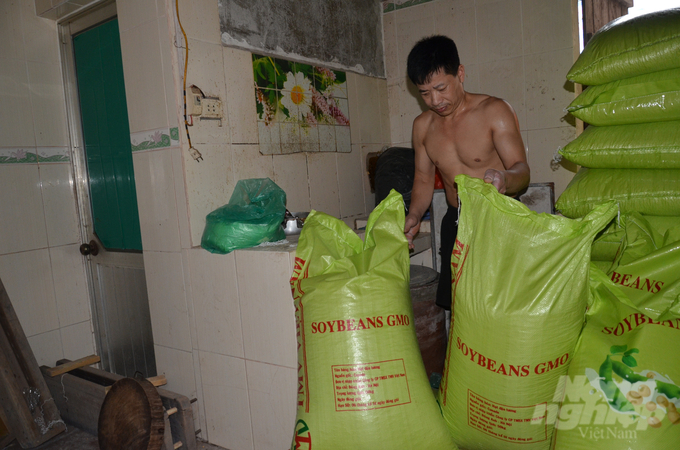
The bean packs in the warehouse of Phan Van Hong have the word “GMO” on them but do not give Vietnamese explanations as per regulations. Photo: Duong Dinh Tuong.
In the dark warehouse, the light bulb was burned, Mr. Phan Van Hong had to open the small window to give a little dim light to show me two types of soybeans he was using to make tofu. I noticed a series of green bags piled up on each other, on which printed the words Soybeans GMO, or genetically modified soybeans but this information was not specified in Vietnamese. The package originated from Canada, distributed by TMV Vietnam in Dong Anh, Hanoi.
Sitting by the stove full of smoke from the coal, Ms. Nguyen Thi Quynh, Mr. Hong's wife, just let down the concrete used to squeeze the beans but instantly stretched her arm to get the sour plastic ladle filled with sour water to prepare for the new batch. The couple had to wake up at 11 pm and rest after 11 am. Every day they process 50-60 kg of tofu.
“The soybean in our homeland is always better, before the season around October and November there were several months to buy the beans. Now not many people want to grow soybeans because the work was arduous and not profitable, so we have only been using Canadian and American beans for a while now. We buy from Ms. Van for VND 17,000-18,000/kg. These two types are even in terms of quality, the price is the same, probably imported by two companies. If it is beautiful soybeans and we can make many tofu from it, we would take it. Usually I buy a bunch, only refill when we sold out”.
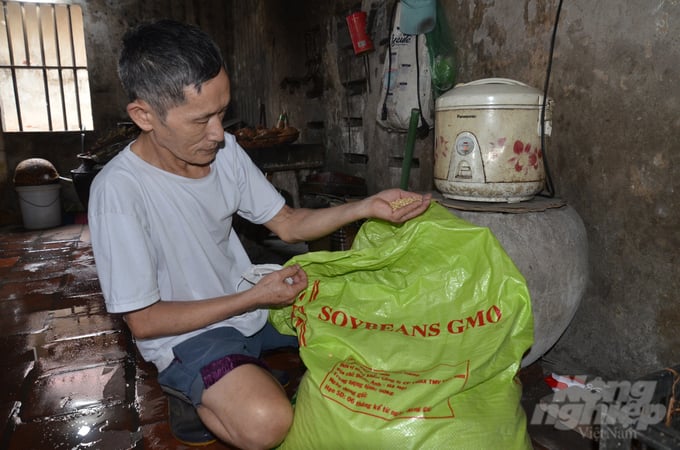
The bean pack Mr. Nguyen Van Buoi have is noted as “GMO” instead of explaining what it means in Vietnamese. Photo: Duong Dinh Tuong.
Mr. Nguyen Van Buoi and Ms. Nguyen Thi Hiep have been making tofu for 30 years. Many days she did not sell well at the market, she had to take the tofu to the street, calling acquaintances to somehow take the tofu.
When asked about the raw material soybean, Mr. Buoi dragged from the corner of the kitchen a familiar green sack of the Vietnamese TMV company with the word “Soybeans GMO” on it once again, imported from Canada but does not have any note in Vietnamese as prescribed by the law.
“Previously, there were still native soybeans in the past but we have not seen it anymore recently. Native soybean prices are always VND 10,000/kg more expensive than imported soybeans, while people still pay the same price for a block of tofu, so not very profitable. Therefore, when the goods arrive I have to mix both native beans and imported beans in a 50/50 ratio,” said Ms. Hiep.
More than half of the space of Mrs. Nguyen Thi Van’S store is filled with soybean packages for each type. Only the ones of TMV Vietnam Company had the word “Soybeans GMO”, and other companies do not it. As it was a time of few guests, she continued to talk to me in a welcoming way:
“In the past, 90% of the houses in the village made beans, now there are roughly 10%, almost my house was the only one to survive in the business because I signed contracts with industrial parks, collective kitchens, supermarkets, and schools in Hanoi. Mam Xanh Company was of my son and daughter, founded along with a man in Phuong Trach. It has 9-10 employees. On a day when they produce a lot, they use 500 kg of beans and 300 kg on an average day”.
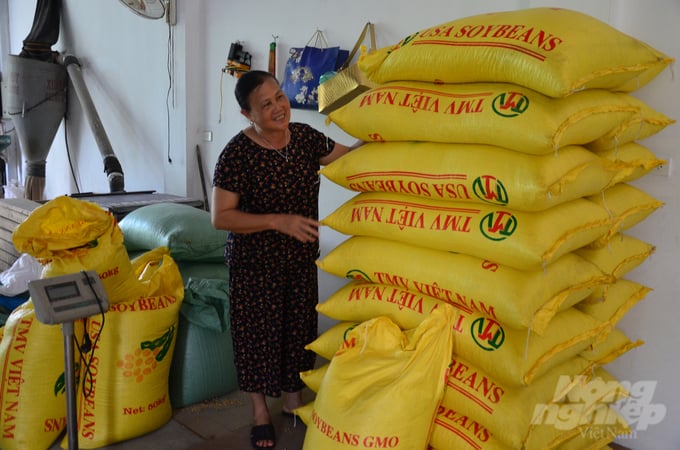
Ms. Nguyen Thi Van besides the "GMO" soybean packages without any explanation in Vietnamese. Photo: Duong Dinh Tuong.
“In the past, there were native soybeans so the business was thriving because tofu sold well those days. The tofu we made was rich in flavor, but we have not been able to see that quality for more than 20 years. All soybeans are now from Canada and the USA”.
An imported soybean trader told me that, if I only reflect on the situation of one or two tofu villages in Hanoi using GMO soybeans, it would be unfair since most villages and tofu making facilities are using the same thing. Therefore, I decided to cross the Duong River to come to a village where the largest blocks of tofu were made.
Translated by Samuel Pham
![Turning wind and rain into action: [4] Bringing climate bulletins to remote and isolated areas](https://t.ex-cdn.com/nongnghiepmoitruong.vn/608w/files/linhnhp/2025/06/14/1152-z6704423696987_15fd32ffc26d590d204d520c9dac6786-nongnghiep-151141.jpg)
(VAN) The Vietnam Agriculture and Nature Newspaper interviewed Mr. Vu Thai Truong, Acting Head of Climate Change and Environment at UNDP Vietnam, to gain deeper insight into how climate bulletins are delivered to farmers.

(VAN) In Tien Giang, a high-tech shrimp farm has developed a distinctive energy-saving farming model that has yielded promising results.
![Turning wind and rain into action: [3] 300.000 farmers benefit from agro-climatic bulletins](https://t.ex-cdn.com/nongnghiepmoitruong.vn/608w/files/news/2025/06/12/e5a48259d6a262fc3bb3-nongnghiep-125122.jpg)
(VAN) The agro-climatic bulletin has become a valuable tool for farmers in the Mekong Delta. After more than five years of implementation, the initiative is gradually being expanded nationwide.
![Turning wind and rain into action: [2] Providing forecasts to the people](https://t.ex-cdn.com/nongnghiepmoitruong.vn/608w/files/news/2025/06/12/e5a48259d6a262fc3bb3-nongnghiep-103927.jpg)
(VAN) In addition to improving the quality of hydrometeorological forecasts, putting forecast bulletins into practical use is crucial for production and disaster prevention.
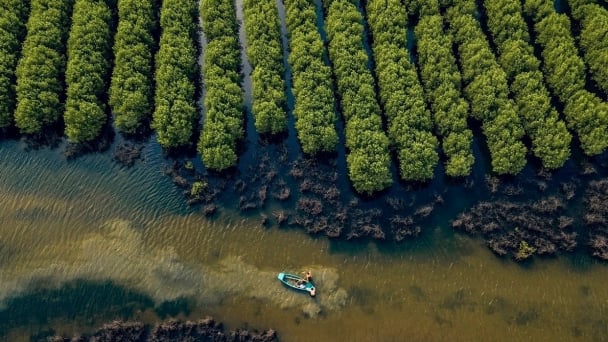
(VAN) Blue carbon is receiving attention for its rapid absorption capacity and vast potential. It represents a promising nature-based solution to respond to climate change.
/2025/06/11/3507-1-161904_583.jpg)
(VAN) Seagrass beds and coral reefs serve as 'cradles' that nurture life in the ocean depths, creating rich aquatic resources in Vietnamese waters.
![Turning wind and rain into action: [1] Forecasting for farmers](https://t.ex-cdn.com/nongnghiepmoitruong.vn/608w/files/news/2025/06/11/e5a48259d6a262fc3bb3-nongnghiep-111919.jpg)
(VAN) Weather is no longer just a matter of fate. Forecasts have now become an essential companion for farmers in every crop season.